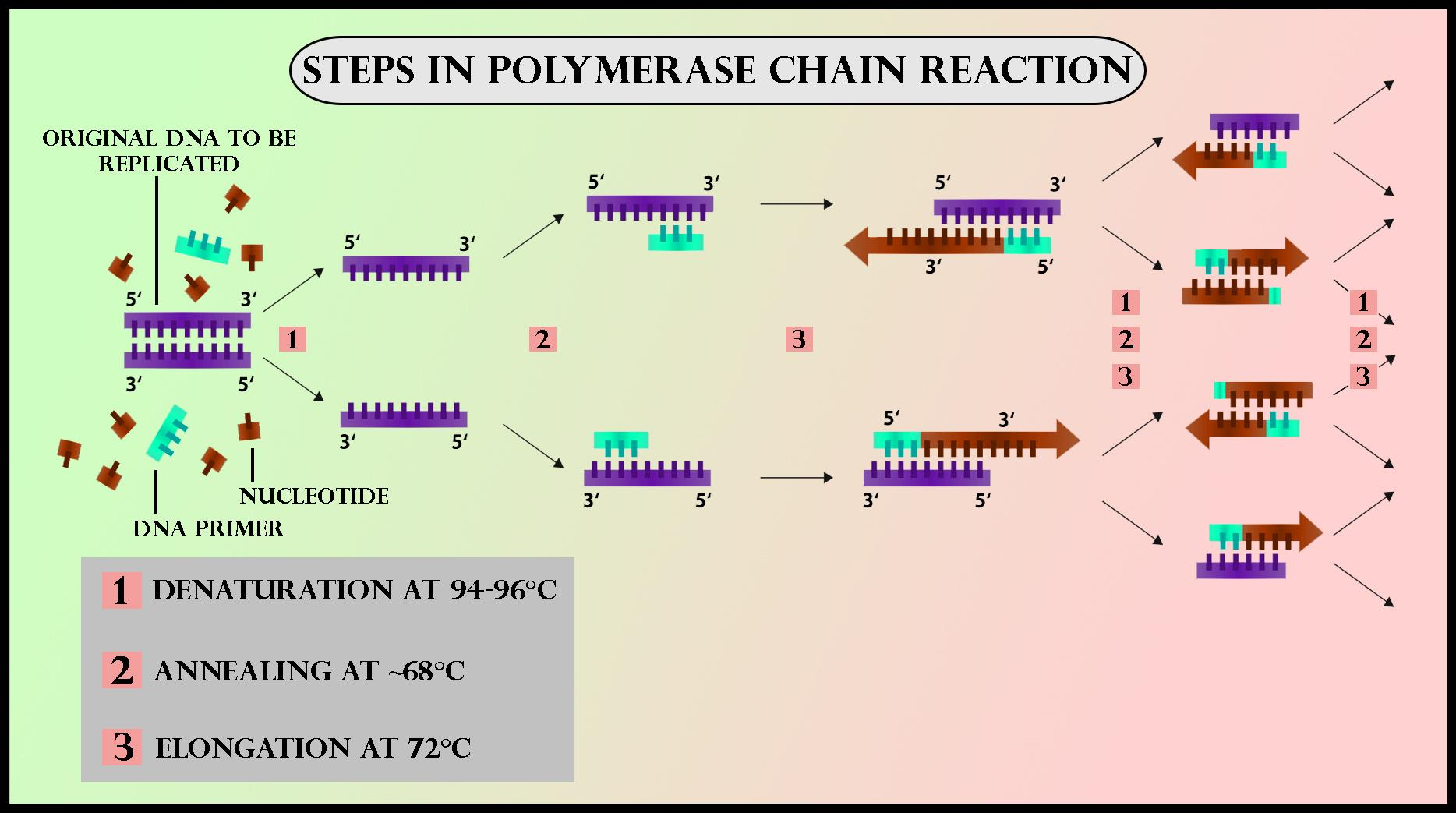
Answer
454.5k+ views
Hint: The process of polymerase chain reaction is defined by the sequences given in the question. Polymerase chain reaction (PCR) is a process commonly used to produce millions to billions of copies of a particular DNA sample quickly, enabling scientists to take a very small DNA sample and amplify it to a large amount for detailed analysis.
Complete answer:
The proper sequence of biotechnological reaction phases is as follows:
-Genomic DNA template
-Denaturation of ds-DNA
-Primers
-Nucleotides provided
-Thermostable DNA polymerase (from Thermus aquaticus)
-Enzyme DNA polymerase
-Chemically synthesized oligonucleotides
-Complementary region of DNA
-In-vitro synthesis of copies of DNA of interest
The American biochemist Kary Mullis at Cetus Corporation developed the PCR in 1984.
In the first step of PCR, in a process called nucleic acid denaturation, the two strands of the DNA double helix are physically separated at a high temperature. The temperature is lowered in the second step and the primers bind to the complementary DNA sequences. The two DNA strands then become DNA polymerase templates for enzymatically assembling a new DNA strand, the building blocks of DNA, from free nucleotides. The DNA produced is itself used as a template for replication as PCR progresses, setting a chain reaction in motion in which the original DNA template is exponentially amplified.
Note: The quantity of the amplified product in the reaction is determined by the available substrates, which are limited as the reaction progresses.
Several components and reagents are needed for a simple PCR set-up, including a DNA template containing the DNA target region for amplification, a DNA polymerase-an enzyme that polymerizes new DNA strands, heat-resistant Taq polymerase are especially prevalent as it is more likely to remain intact during the process of high-temperature DNA denaturation, two DNA primers that are complementary to the 3' ends of the DNA target, dNTPs (called deoxynucleotide triphosphates)-triphosphate group nucleotides, a buffer solution providing an adequate chemical environment for optimum DNA polymerase activity and stability, and bivalent cations, usual ions of magnesium ( Mg) or manganese (Mn).

Complete answer:
The proper sequence of biotechnological reaction phases is as follows:
-Genomic DNA template
-Denaturation of ds-DNA
-Primers
-Nucleotides provided
-Thermostable DNA polymerase (from Thermus aquaticus)
-Enzyme DNA polymerase
-Chemically synthesized oligonucleotides
-Complementary region of DNA
-In-vitro synthesis of copies of DNA of interest
The American biochemist Kary Mullis at Cetus Corporation developed the PCR in 1984.
In the first step of PCR, in a process called nucleic acid denaturation, the two strands of the DNA double helix are physically separated at a high temperature. The temperature is lowered in the second step and the primers bind to the complementary DNA sequences. The two DNA strands then become DNA polymerase templates for enzymatically assembling a new DNA strand, the building blocks of DNA, from free nucleotides. The DNA produced is itself used as a template for replication as PCR progresses, setting a chain reaction in motion in which the original DNA template is exponentially amplified.
Note: The quantity of the amplified product in the reaction is determined by the available substrates, which are limited as the reaction progresses.
Several components and reagents are needed for a simple PCR set-up, including a DNA template containing the DNA target region for amplification, a DNA polymerase-an enzyme that polymerizes new DNA strands, heat-resistant Taq polymerase are especially prevalent as it is more likely to remain intact during the process of high-temperature DNA denaturation, two DNA primers that are complementary to the 3' ends of the DNA target, dNTPs (called deoxynucleotide triphosphates)-triphosphate group nucleotides, a buffer solution providing an adequate chemical environment for optimum DNA polymerase activity and stability, and bivalent cations, usual ions of magnesium ( Mg) or manganese (Mn).

Recently Updated Pages
Identify the feminine gender noun from the given sentence class 10 english CBSE

Your club organized a blood donation camp in your city class 10 english CBSE

Choose the correct meaning of the idiomphrase from class 10 english CBSE

Identify the neuter gender noun from the given sentence class 10 english CBSE

Choose the word which best expresses the meaning of class 10 english CBSE

Choose the word which is closest to the opposite in class 10 english CBSE

Trending doubts
How do you graph the function fx 4x class 9 maths CBSE

Fill the blanks with the suitable prepositions 1 The class 9 english CBSE

Which are the Top 10 Largest Countries of the World?

A rainbow has circular shape because A The earth is class 11 physics CBSE

Change the following sentences into negative and interrogative class 10 english CBSE

The Equation xxx + 2 is Satisfied when x is Equal to Class 10 Maths

Give 10 examples for herbs , shrubs , climbers , creepers

Difference between Prokaryotic cell and Eukaryotic class 11 biology CBSE

One Metric ton is equal to kg A 10000 B 1000 C 100 class 11 physics CBSE




